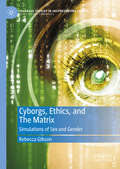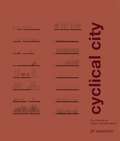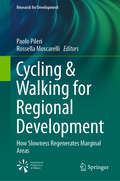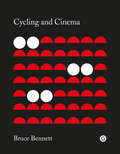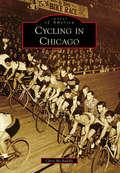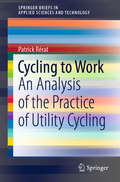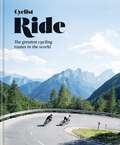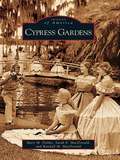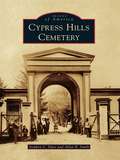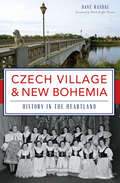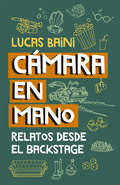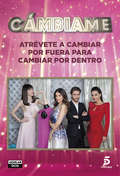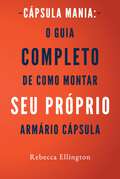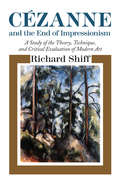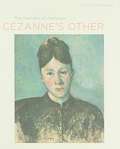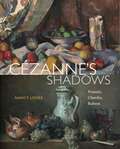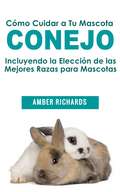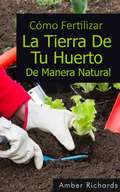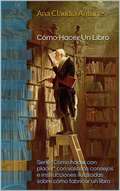- Table View
- List View
Cyborgs, Ethics, and The Matrix: Simulations of Sex and Gender (Palgrave Studies in (Re)Presenting Gender)
by Rebecca GibsonThe Matrix (Lana Wachowski and Lilly Wachowski 1999) has permeated our cultural consciousness for two decades, working its way into such common parlance as “a glitch in the Matrix,” and the idea of taking the Red Pill. With the release of the fourth movie, The Matrix Resurrections (Lana Wachowski 2021), and the confirmation of the franchise being a metaphor for gender transition, this book examines how the entire franchise contributes to the discourse on sex and gender, and how it has been instrumental in propelling the creation of new types of cyborg technology. This book centers on the main philosophical theme of The Matrix, know thyself, and relate it to the quest for authenticity which creates our identities—be they human, or human “enough”—as we move through the world.
Cyclical City: Five Stories of Urban Transformation
by Jill DesiminiAs cities evolve and resources shift with time, spaces within those cities are often left fallow and abandoned. Cyclical City tells the stories behind these sites, from Philadelphia’s Liberty Lands park to Lisbon’s Green Plan, and it looks at the ways in which these narratives can be leveraged toward future engagement and use. Jill Desimini posits a fundamental role for spatial design practice to transform abandoned urban landscapes through time. She argues for approaches that promote the specific affordances of the land itself (hydrology, vegetation, topography, geology, infrastructural capacity, occupation potential); the importance of cyclical change; and the particularities of the cultural, political, and physical context. These themes are explored in five cities—Philadelphia, Berlin, Lisbon, Amsterdam, and Saint Louis—and across centuries, from periods of great upheaval to ones of relative stability and even economic growth. Desimini considers what landscape-driven design can bring to cities losing people and economic resources, how design practice can be more inclusive in a context of market failure, and the ways in which abandoned landscapes can become our commons.Preparation of this volume has been supported by Furthermore: a program of the J. M. Kaplan Fund
Cycling & Walking for Regional Development: How Slowness Regenerates Marginal Areas (Research for Development)
by Paolo Pileri Rossella MoscarelliThis book investigates why and how cycle and walking paths can help to promote the regeneration of marginalized areas facing depopulation and economic decline. In addition, it offers a broad overview of recent scientific research into slow tourism and marginality/spatial inequality and explores the linkages between these topics. Key issues are addressed by experts from various disciplinary backgrounds, and potential measures are proposed for the integration of slow tourism into strategies for regional development. Particular attention is devoted to the VENTO project, which involves the creation of a 700-km-long cycle route from Venice to Turin that passes through various rural and marginalized areas of northern Italy. The goal, research process, design, and early lessons from this important project are all discussed in detail. Moreover, the book describes policies and strategies that have successfully been used to enhance the slow tourism infrastructure in other European countries. Given its scope, the book will appeal to researchers, professionals, and students interested in e.g. policymaking, tourism planning, regional development, and landscape and urban planning.
Cycling and Cinema (Goldsmiths Press Ser.)
by Bruce BennettA unique exploration of the history of the bicycle in cinema, from Hollywood blockbusters and slapstick comedies to documentaries, realist dramas, and experimental films.Cycling and Cinema explores the history of the bicycle in cinema from the late nineteenth century through to the present day. In this new book from Goldsmiths Press, Bruce Bennett examines a wide variety of films from around the world, ranging from Hollywood blockbusters and slapstick comedies to documentaries, realist dramas, and experimental films, to consider the complex, shifting cultural significance of the bicycle. The bicycle is an everyday technology, but in examining the ways in which bicycles are used in films, Bennett reveals the rich social and cultural importance of this apparently unremarkable machine. The cinematic bicycles discussed in this book have various functions. They are the source of absurd comedy in silent films, and the vehicles that allow their owners to work in sports films and social realist cinema. They are a means of independence and escape for children in melodramas and kids' films, and the tools that offer political agency and freedom to women, as depicted in films from around the world.In recounting the cinematic history of the bicycle, Bennett reminds us that this machine is not just a practical means of transport or a child's toy, but the vehicle for a wide range of meanings concerning individual identity, social class, nationhood and belonging, family, gender, and sexuality and pleasure. As this book shows, two hundred years on from its invention, the bicycle is a revolutionary technology that retains the power to transform the world.
Cycling in Chicago (Images of America)
by Chris McauliffeIn the late 19th and early 20th century, Chicago was the center of bicycle manufacturing in the United States. As an early industrial and transportation center, two-thirds of all bicycles manufactured in the United States were from Chicago�it was the Detroit of bike manufacturing. For decades, Chicago was also a center for cycling track and road racing. Six-day races drew capacity crowds at the Chicago Stadium, Chicago Coliseum, and International Amphitheatre. Road and track competitions were also held at Sherman Park, the Humboldt Park Velodrome, and on Chicago�s famed Magnificent Mile. Today, Chicago is a hub for recreational cyclists. Hundreds of miles of bike lanes, rail to trails, and bike paths, such as the Illinois Prairie Path, the Bloomingdale Trail, Lakefront Path, and the Big Marsh, provide cyclists with numerous recreational and commuting options in a crowded urban environment. Chicago was awarded Bicycling Magazine�s Best Bike City of 2016.
Cycling to Work: An Analysis of the Practice of Utility Cycling (SpringerBriefs in Applied Sciences and Technology)
by Patrick RératThis book presents a thorough discussion of utility cycling, cycling in the urban environment, and everyday mobility. It is based on large survey answered by 14,000 participants in the bike to work action in Switzerland, and quantifies the various dimensions of utility cycling.It proposes an innovative theoretical framework to analyse and understand the various dimensions of the uses of bikes and their diversity. It addresses the factors that motivate commuters to get on their bike, and highlights the barriers to this practice between deficient infrastructures and lack of legitimacy. This research makes a diagnosis and discusses the way to develop this sustainable mode of transportation. By combining quantitative results in the form of tables, figures, and maps, and including qualitative results in the form of quotations from survey participants, this book provides a thorough and enjoyable read. It will be of interest to researchers, policy makers, advanced students in the field of urban planning, social sciences, and transportation.
Cyclist – Ride: The greatest cycling routes in the world
by CyclistExplore 50 of the greatest, most thrilling road cycling routes the world has to offer, guided by the experts at the world's biggest road cycling magazine. Route maps, first-hand ride reports and truly breathtaking photography from the finest cycling photographers come together in this celebration of the world on two wheels.Covering the very best of Europe, from the twisting trails of northern Norway to the winding coast of southern Spain, this beautiful book also includes rides from as far afield as Vietnam, Ethiopia and Lebanon, as well as the USA.
Cyclist – Ride: The greatest cycling routes in the world
by CyclistExplore 50 of the greatest, most thrilling road cycling routes the world has to offer, guided by the experts at the world's biggest road cycling magazine. Route maps, first-hand ride reports and truly breathtaking photography from the finest cycling photographers come together in this celebration of the world on two wheels.Covering the very best of Europe, from the twisting trails of northern Norway to the winding coast of southern Spain, this beautiful book also includes rides from as far afield as Vietnam, Ethiopia and Lebanon, as well as the USA.
Cypress Gardens
by Mary M. Flekke Randall M. Macdonald Sarah E. MacdonaldFlorida's first theme park, Cypress Gardens, was the brainchild of Richard Downing Dick" Pope Sr. With his wife, Julie Downing Pope, he transformed a marshy, lakeside property in Winter Haven into a magnificent garden. The park's first visitors in 1936 toured pathways surrounded by lush plants from around the world. Two years later, electric boats meandered through the park's winding, hand-dug canals. Water ski shows commenced in 1942, and the park became the "Water Ski Capital of the World." The Florida-shaped Esther Williams Swimming Pool still graces the shore of Lake Eloise. The park was a set for dozens of short feature films, a stage for beauty pageants, and a site for special television broadcasts. A butterfly garden, zoo, rides, and the small-town Southern Crossroads shopping and dining area remain popular features. Kent Buescher purchased Cypress Gardens in 2004, and today's expanded Cypress Gardens Adventure Park preserves the family-friendly appeal of Dick and Julie Pope's magnificent park."
Cypress Hills Cemetery
by Stephen C. Duer Allan B. SmithFor the past 162 years, historic Cypress Hills Cemetery has quietly served thousands of New Yorkers and the public at large. This place of eternal rest obtained the distinct honor of being the first rural cemetery in Greater New York to be organized under the Rural Cemetery Act of 1847. Cypress Hills provides a perfect balance of lush landscaping, funerary art and sculpture, and a final resting place for some of America's most notable figures, such as Jackie Robinson, Mae West, and Eubie Blake. Carved on countless headstones are mysterious markings and secretive symbols that the living can ponder. Cypress Hills Cemetery illustrates and demystifies the various legends of those interred in these hallowed grounds.
Czech Village & New Bohemia: History in the Heartland (Brief History)
by Mark Stoffer Hunter Dave RasdalBeginning in the 1870s, thousands of Bohemians flocked to Cedar Rapids in search of a better life. Czech immigrants courageously overcame the difficult conditions of the local packinghouse and the challenge of creating a new home. They maintained a strong cultural identity with Czech music, literature and an undying dedication to family. In the wake of a devastating flood in 2008, the people of Czech Village and New Bohemia re-imagined traditional principles to forge a remarkable resurgence toward a promising future. Author Dave Rasdal travels from the Charles Bridge to the Bridge of Lions in a celebration of Czech heritage and history in Cedar Rapids.
Cámara en mano: Relatos desde el backstage
by Lucas BainiUn fantástico recorrido por el detrás de escena de las películas y series que marcaron tu historia, de la mano de Lucas Baini. Seguramente guardás recuerdos imborrables de tu infancia, viendo tus series animadas favoritas o de las películas y series que marcaron tu adolescencia. Tal vez, te preguntaste miles de veces, cómo se crearon, qué hacían los actores detrás de escena, cómo los eligieron... Bueno, ¡llegó el momento de descubrirlo! Lucas Baini te cuenta todos los secretos y las curiosidades más insólitas del backstage.
Cámaras DSLR: Guía completa para aprender a usar tu cámara DSLR como un profesional
by John Johnson¿Usas regularmente tu cámara réflex digital? ¿Te gustaría aprender cómo usar tu dispositivo Samsung como un profesional y ahorrar mucho tiempo? Compatible con la mayoría de las cámaras DSLR. Si respondes que sí a todas estas preguntas, entonces esta guía es para ti. Sabías que tu cámara DSLR es capaz de realizar cientos de funciones, las cuales te facilitarán la vida y te permitirán ahorrar más tiempo mientras tomas fotos increíbles. Sin embargo, debido a que hay un montón de funciones secretas, resulta muy difícil saber exactamente cómo optimizar tu dispositivo. Incluye: - Cómo configurar tu cámara - Cómo navegar en sus funciones - Capacidades del dispositivo - Cómo ahorrar tiempo - Cómo ahorrar esfuerzo y completar tareas con facilidad. - Aprender a utilizar tu dispositivo como un profesional - Solucionar problemas - Tomar fotografías increíbles Y MUCHO MÁS Si quieres aprender a usar tu dispositivo como un profesional, entonces esta guía es para ti. --> Desplácese hasta la parte superior de la página y haz clic en Agregar al carrito para comprar al instante Aviso legal: Este autor y/o propietario(s) de los derechos no hacen reclamos, promesas o garantías con respecto a la exactitud, integridad o adecuación de los contenidos de este libro, y expresamente renuncia a la responsabilidad por errores y omisiones en los contenidos. Este producto es solo de referencia. Consulte a un profesional antes de tomar medidas sobre cualquiera de los contenidos de este libro.
Cámbiame: Atrévete a Cambiar Por Fuera Para Cambiar Por Dentro
by Varios AutoresDescubre todos los entresijos de Cámbiame, el programa estrella de Tele 5 que mejora la autoestima: los estilistas, los looks al detalle y los cambios más sorprendentes. Y aplica tú mismo los trucos y consejos de los coaches. «Necesito que me tomen en serio», «No quiero parecer un vagabundo», «Quiero ser una estrella del Pop», «Necesito dejar de ser un adefesio»... Estos son algunos de los sueños que pretenden hacer realidad los aspirantes de Cámbiame, el programa de cambio de imagen de Tele 5 presentado por Marta Torné. Los artífices de la transformación son los expertos en moda y cool hunters Pelayo Díaz, Cristina Rodríguez y Natalia Ferviú, capaces de profetizar las tendencias y los must have de la próxima temporada. Gracias a este libro ahora podrás aplicar tú mismo todos los trucos y consejos de los estilistas sin tener que pasar por la temida cinta transportadora. Los mejores cambios de look de los expertos están recopilados aquí, con detallados paso a paso, para mejorar la vestimenta, el peinado o los complementos. Aprenderás que la actitud que proyectas en los demás, el potencial que ocultas y tu personalidad son determinantes para potenciar al máximo tu imagen y conseguir todo lo que te propongas. Con Cámbiame vas a sentir la magia de un estilismo profesional que te cambiará por fuera y por dentro.
Cápsula Mania: O Guia Completo de Como Montar Seu Próprio Armário Cápsula
by Andrea Luri Abe Rebecca EllingtonVocê tem tanta roupa que seu armário parece que vai explodir? Mas, apesar disso, acha que nunca tem nada que vestir e que não consegue se manter ao dia com a moda? Estilo não tem que ser complicado nem caro! E se existisse um método que lhe ajudasse a ficar radiante e satisfeita todos os dias? Com o estilo Armário Cápsula você vai dizer adeus à preocupação de não ter o sapato que combina com tal vestido. Neste guia completo você vai aprender a: - Tirar o máximo proveito do mínimo de peças - Desentulhar seu armário - Ganhar confiança e tranquilidade - Facilmente combinar a mesma peça numa infinidade de estilos para uma infinidade de eventos - Recuperar o controle e transformar o seu estilo e sua vida. Pare de ficar na internet procurando a última moda e comece a construir um guarda-roupa que funcione para você! Tenha um guarda-roupa lhe faça sentir bem por dentro e por fora, que destaque seus pontos fortes e disfarce o que não queira mostrar. Mas como posso sobreviver com só 20 peças ou menos? Adote a magia da Cápsula que é tão fácil montar quanto manter! Seguindo este guia, saberá como um Armário Cápsula pode ser prático e útil na sua vida. Você nunca mais vai querer viver sem o seu! Adquira o seu exemplar de “Cápsula Mania: O Guia Completo de Como Montar Seu Próprio Armário Cápsula” hoje mesmo!
Cézanne and America: Dealers, Collectors, Artists, and Critics, 1891-1921 (The A. W. Mellon Lectures in the Fine Arts #28)
by John RewaldThe classic work by internationally acclaimed Cézanne scholar John RewaldIn Cézanne and America, John Rewald presents a full account of how Paul Cézanne’s reputation and influence became established in America between 1891 and 1921, and of how some of the world’s largest collections of his works were formed in the United States. This is the fascinating story of enthusiastic young American artists who took up Cézanne’s cause after they discovered him in Paris. It is also the story of the discerning early American collectors of his work—Leo and Gertrude Stein, the Havemeyers, and John Quinn, among others—many of whom made their first purchases from Cézanne’s wily dealer Ambroise Vollard in Paris, or from the dealer Alfred Stieglitz in New York, and of the beginning of the famous collection of Dr. Albert C. Barnes. Each chapter is illustrated not only with Cézanne’s works but also with portraits of collectors and critics and with previously unpublished pages from diaries, dealers’ ledgers, and Cézanne’s own correspondence.
Cézanne and the End of Impressionism: A Study of the Theory, Technique, and Critical Evaluation of Modern Art
by Richard ShiffDrawing on a broad foundation in the history of nineteenth-century French art, Richard Shiff offers an innovative interpretation of Cézanne's painting. He shows how Cézanne's style met the emerging criteria of a "technique of originality" and how it satisfied critics sympathetic to symbolism as well as to impressionism. Expanding his study of the interaction of Cézanne and his critics, Shiff considers the problem of modern art in general. He locates the core of modernism in a dialectic of making (technique) and finding (originality). Ultimately, Shiff provides not only clarifying accounts of impressionism and symbolism but of a modern classicism as well.
Cézanne and the Post-Bionian Field: An Exploration and a Meditation
by Robert SnellBy inviting a ‘conversation’ between them, this book offers a nuanced introduction both to Cézanne—the ‘father of modern art’—and perhaps the most vital body of theory in contemporary psychoanalysis, ‘post-Bionian field theory’, as it has been evolving in Italy in the hands of Antonino Ferro, Giuseppe Civitarese, and others. Cézanne and Bion, each insisting on his own truths, spearheaded quite new directions in painting and in psychoanalysis. Both point us towards a crucial insight: far from being isolated, self-contained ‘subjects’, we fundamentally exist only within a larger interpersonal ‘field’. Cézanne’s painting can give us a direct experience of this. For the Italian field analysts, building on Bion’s work, the field is accessed through reverie, metaphor, and dream, which now come to occupy the heart of psychoanalysis. Here primitive ‘proto-emotions’ that link us all might be transformed—as Cézanne transformed his ‘sensations’—into aesthetic form, into feelings-linked-to-thoughts that in turn enrich and expand the field. The book draws on the words of artists (Cézanne himself, Mann), philosophers (Merleau-Ponty, Bergson), art historians and theorists (Clark, Smith, Shaw), as well as psychoanalysts (Bion, Ferro, Civitarese, and others), and it is the first to focus on one particular—and seminal—painter as a way of exploring this aesthetic and ‘field’ dimension in depth and detail. Aimed at psychoanalysts, psychotherapists, artists, art historians, and the general reader, it suggests how far art and contemporary psychoanalysis are mutually generative.
Cézanne's Other: The Portraits of Hortense
by Susan SidlauskasSusan Sidlauskas breaks new ground, focusing on the paintings of Zanne as a group and looking particularly at the differences that render many of them unrecognizable as the same person.
Cézanne: A Study of His Development
by Roger FryThe late Roger Fry was an art critic of unequalled perception and influence. One of his missions was to work for a better understanding of the Impressionist school and, above all, to claim for Cézanne (1839-1906) the great place that was rightfully his. In CÉZANNE Fry wrote a critical analysis which in many aspects has never been surpassed. He achieved with conspicuous success a two-fold aim: to show the essential development of the painter’s genius and to approach his work as it really is; as Fry himself words it, to detect the profound difference between Cézanne’s message and what we have made of it.”The result is a book, couched in Fry’s most lucid, penetrating manner, which is of great technical value to the painter and student, and which offers to the layman an illuminating demonstration of the essential nature of Cézanne’s art.
Cézanne’s Shadows: Poussin, Chardin, Rubens
by Nancy LockeModernism has often been described as a rejection of the art of the past, but Cézanne’s Shadows makes an eloquent case for precisely the opposite artistic practice.In this book, Nancy Locke argues that the idea of a modernist forgetting would never have taken hold if the modernist painters themselves, and Cézanne in particular, had not wrestled so fiercely with the work of their predecessors. Cézanne routinely interrupted his work with a model to go back to the Louvre or to consult sketches and studies he did after the old masters. Exploring the importance of Cézanne’s involvement with the art of the past in essays devoted to Poussin, Chardin, and Rubens, Locke argues that Cézanne’s art cannot be understood without an investigation into what he made of these earlier models and how they continued to haunt even his mature work.Cézanne’s Shadows offers an elegant new model for understanding the relationship between modernist painting and the creative tradition it often feigns to reject. This study of artistic ambitions and an analysis of nineteenth-century art writing will be especially valuable to scholars of modernism and European art history.
Cómo Cuidar a Tu Mascota Conejo
by Amber Richards David Arieta GalvánSi estás criando conejos para competencias o disfrutas las apacibles comodidades de estas juguetonas criaturas, te verás beneficiado si aprendes los fundamentos del cuidado y alimentación de los conejos. Escrito por una criadora profesional de conejos, Cómo Cuidar a Tu Mascota Conejo es una guía de cuidado extensiva para los amantes de los conejos, que quieren los detalles sobre los cuidados del conejo, en lugar de los conocimientos sobre su crianza. Mantén a tu conejo saludable y contento; te guiaremos a través del proceso, paso a paso. ¡Aprenderás cómo construir una madriguera, el cuidado de las uñas y dientes, cómo alimentarlo, preparar su cama y mucho más! Esta es una guía para propietarios de conejos, al contrario de una para la crianza comercial, así que no profundiza en este tema. Desde la pequeña contracción de la nariz hasta el cuerpo suave y sedoso, rápidamente te enamorarás de tu nuevo compañero peludo. Descubre una completa y exhaustiva lista de razas reconocidas por la American Rabbit Breeders Association. Aprenderás exactamente cuáles razas son mascotas apropiadas para tu familia y cuáles evitar. Consigue tu ejemplar de Cómo Cuidar Tu Mascota Conejo hoy y experimenta las maravillosas alegrías que un conejo te traerá.
Cómo Fertilizar La Tierra De Tu Huerto De Manera Natural
by Alejandro Vargas Giraldo Amber RichardsLlena de energía tu huerto fertilizando la tierra al máximo sin aditivos artificiales. Cómo fertilizar la tierra de tu huerto de manera natural es un sencillo manual que te ayudará a obtener frutas deliciosas, verduras saludables, flores aromáticas y maravillosas hierbas. Si nunca construirías tu casa sobre cimientos en mal estado, ¿por qué seguir cultivando plantas enfermas sobre tierra de mala calidad?Sea cual sea tu habilidad con la jardinería, Cómo fertilizar la tierra de tu huerto de manera natural te guiará para que consigas casi sin esfuerzo un próspero huerto rebosante de plantas de todo tipo y, cómo no, con alegres pájaros que cantarán siempre tu melodía favorita. Cuando veas los resultados te preguntarás por qué no lo habías hecho antes. Aprenderás a aumentar enormemente el nivel de nutrientes de la tierra y a mejorar su textura, así como a mantener el huerto en buen estado sin importar las condiciones meteorológicas. Si utilizas las técnicas naturales que se describen en este libro, disfrutarás con orgullo de un huerto floreciente y de cosechas nutritivas y deliciosas en cualquier temporada.Consigue ya tu ejemplar de Cómo fertilizar la tierra de tu huerto de manera natural y transforma tu huerto en un exuberante oasis donde tus plantas podrán crecer sanas.
Cómo Hacer Un Libro
by Ana Bowlova Ana Claudia AntunesAlguna vez se preguntó cómo se hace un libro? Como hacer de ellos lindos regalos originales o como objectos de intereses personales? Con instrucciones de seguimiento sencillas, todas con temas ilustrados, este libro describe un paso a paso "fácil de hacer y listo para tecer" en un método que se puede aplicar con diferentes patrones y temas para una variedad de uso. Desde lindos carteras professionales hasta álbumes para toda la familia, este libro hará que usted haga un montón de hermosos, exquisitos, deslumbrantes, creativos e inolvidables otros libros. Todo depende de usted para comenzar. ¿Estás listo para hacer una lista a quien regalarlos?
Cómo Hacer Vino, Para El Absoluto Novato
by Kyle Richards Marcela Gutiérrez BravoSi eres un conocedor de vino o un sorbedor casual de fin de semana, ¡Cómo Hacer Vino, Para el Absoluto Novato es la guía perfecta para poner el orgullo y el placer de hacer vino en tus manos! ¡No te intimides por los acres de uvas y las granjas de equipo pesado en los viñedos, tú puedes hacer delicioso vino en casa, y este e-book te muestra cómo! ¡No necesitas experiencia, hemos fraccionado el proceso en pequeños pasos de modo que cualquiera pueda hacer delicioso y fragante vino en tu propio hogar y divertirte haciéndolo! Comparte con tu familia y amigos o guarda para ocasiones especiales. Es tan gratificante dar una botella de vino que hiciste a un amigo o ser querido como regalo. Algunas de las preguntas communes que nunca se han hecho sobre el vino son: ¿Qué tipo de uva debo usar? ¿Qué equipo necesito? ¿Qué tan caro es ese equipo? ¿Es difícil hacer vino en casa? ¿Cómo se hace el vino? Este libro menciona estas preguntas y más. Con nuestro simple proceso, tu vino favorite pronto tundra tu nombre en la etiqueta. No más quedarse mirando a las interminables gavetas de vinos misteriosos y caros en la tienda. Cómo Hacer Vino, Para el Absoluto Novato te asegurará que puedes comenzar a hacer tu propio vino en cualquier momento.
